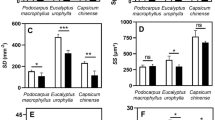Abstract
Stomatal frequency in leaves of plants of Iris hollandica, cultivated under four light intensities, about 12%, 37%, 75% and 100% of natural daylight, was studied. The stomatal frequency decreases with lower light intensities. The gradients of stomatal frequency of successive leaves show an increase up to the third or fourth leaf with a subsequent decrease of values up to the highest leaf. The total number of stomata per leaf is not constant; differences exist in successive leaves of a shoot as well as among the leaves of plants growing under various light intensities. The character of gradients was changed at lower light intensities. The largest reaction to the light intensity appeared in leaves with higher stomatal frequency. The gradients in individual leaves depend on the insertion of the leaf. Both the shape and the slope of these gradients are influenced by the light intensity.
Similar content being viewed by others
References
Clements, F. E., Long, F. L.: Further studies of elongation and expansion inHelianthus phytometers.—Plant Physiol.10: 637–660, 1935.
Farkas, G. L., Rajháthy, T.: Untersuchungen über die xeromorphischen Gradienten einiger Kulturpflanzen.—Planta45: 535–548, 1955.
Goette, W.: Untersuchungen über die Beeinflussung des anatomischen Baues einiger Liliaceen durch Standortsfaktoren und experimentelle Eingriffe (Blausäure-Begasung).—Beitr. Biol. Pfl.19: 35–66, 1932.
Gupta, B.: Correlation of tissues in leaves. 2. Absolute stomatal numbers.—Ann. Bot. N.S.25: 71–77, 1961.
Lundkvist, L. O.: Wasserüberschuss und Stickstoffmangel als Ursache gewisser Strukturveränderungen bei Mesophyten.—Svensk bot. Tidskr.49: 387–418, 1955.
Migahid, A. M., Abu Raya, M. A.: Studies in stomatal frequency II. Stomatal frequency in relation to position of leaf upon the plant.—Bull. Inst. Fouad I. Désert, Cairo2/2: 48–59, 1952a.
Migahid, A. M., Abu Raya, M. A.: Studies in stomatal frequency III. Analysis of factors affecting the distribution of stomata among the leaves of a plant.—Bull. Inst. Fouad I. Désert, Cairo2/2: 60–63, 1952b.
Mikyška, R.: Lesy na Plzeňsku.—Věstn. král. čes. Společ. Nauk, Praha, Cl. math.-natur., 1943/13: 1–60, 1944.
Němec, B. et al.: Botanická mikrotechnika. [Plant Microtechnique.]—Praha, 1962.
Pazourek, J.: Studium listové epidermis mikroreliefovou metodou. [Study of the epidermis of leaves by microrelief method.].—Preslia35: 210–216, 1963.
Pazourek, J.: Anatomical gradients of stomatal apparatus in leaves ofHordeum distichon L.— Adv. front. of plant sci.23: 9–18, 1969.
Pisek, A., Cartellieri, E.: Zur Kenntnis des Wasserhaushaltes der Pflanzen. II. Schattenpflanzen.— Jb. wiss. Bot.75: 643–678, 1932.
Prat, H.: Histo-physiological gradients and plant organogenesis.—Bot. Rev.14: 603–643, 1948.
Rea, W. M.: Stomata and hydatodes inCampanula rotundifolia L., and their relation to environment.— New Phytol.20: 56–72, 1921.
Salisbury, E. J.: On the cause and ecological significance on stomatal frequency, with special reference to the woodland flora.—Philos. Trans. Roy. Soc. London216B: 1–65, 1927.
Wassink, E. C.: The effect of light intensity on growth and development ofGladiolus.—Progress in Photobiology. Proc. 3rd internat. congress on photobiol., Copenhagen1960: 371–378, 1960.
Wassink, E. C.: On some quantitative relationships between anatomy and light induced formative differences inGladiolus stems.—Meded. Landbouwhogeschool Wageningen63: 1–8, 1963.
Wassink, E. C.: Light intensity effects in growth and development of tulips, in comparison with those inGladiolus.—Meded. Landbouwhogeschool Wageningen65 (15): 1–21, 1965a.
Wassink, E. C.: Some introductory notes onTaraxacum officinale L. as an experimental plant for morphogenetic and production research.—Meded. Landbouwhogeschool Wageningen65(16): 1–15, 1965b.
Zalenskij, V.: Matěrialy k količestvennoj anatomii različnych list’jev odnich i těch že rastěnij.—Kijev 1904.
Author information
Authors and Affiliations
Additional information
Address: Viničná 5, Praha 2, Czechoslovakia.
Rights and permissions
About this article
Cite this article
Pazourek, J. The effect of light intensity on stomatal frequency in leaves ofIris hollandica hort., var. wedgwood. Biol Plant 12, 208–215 (1970). https://doi.org/10.1007/BF02920869
Received:
Published:
Issue Date:
DOI: https://doi.org/10.1007/BF02920869




